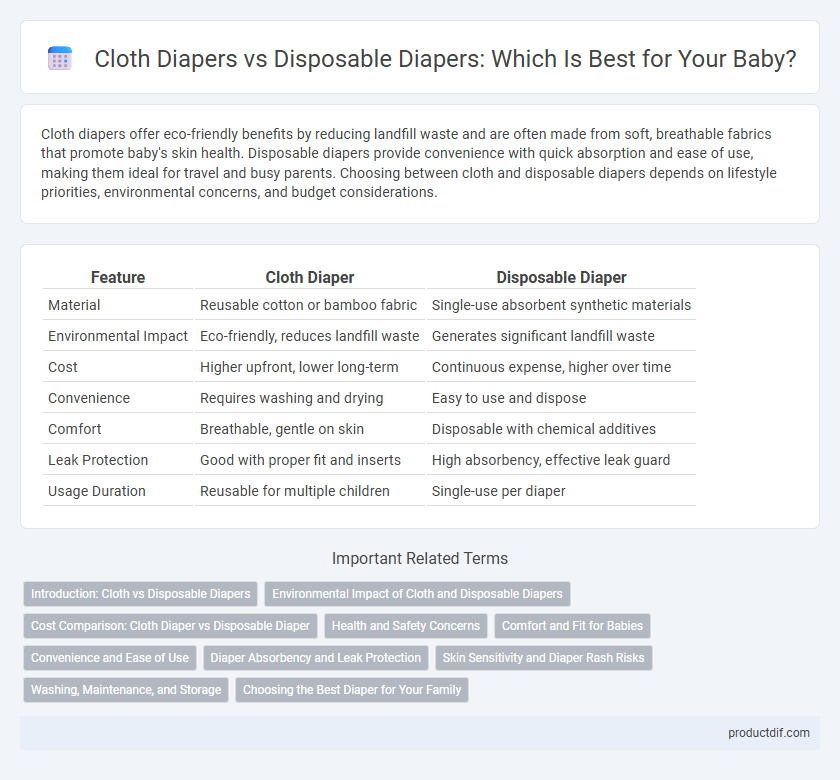Cloth diapers offer eco-friendly benefits by reducing landfill waste and are often made from soft, breathable fabrics that promote baby's skin health. Disposable diapers provide convenience with quick absorption and ease of use, making them ideal for travel and busy parents. Choosing between cloth and disposable diapers depends on lifestyle priorities, environmental concerns, and budget considerations.
Table of Comparison
| Feature | Cloth Diaper | Disposable Diaper |
|---|---|---|
| Material | Reusable cotton or bamboo fabric | Single-use absorbent synthetic materials |
| Environmental Impact | Eco-friendly, reduces landfill waste | Generates significant landfill waste |
| Cost | Higher upfront, lower long-term | Continuous expense, higher over time |
| Convenience | Requires washing and drying | Easy to use and dispose |
| Comfort | Breathable, gentle on skin | Disposable with chemical additives |
| Leak Protection | Good with proper fit and inserts | High absorbency, effective leak guard |
| Usage Duration | Reusable for multiple children | Single-use per diaper |
Introduction: Cloth vs Disposable Diapers
Cloth diapers are made from natural or synthetic fabrics that can be washed and reused multiple times, offering an eco-friendly and cost-effective alternative to disposable diapers. Disposable diapers consist of absorbent materials designed for single use, providing convenience and superior leakage protection for busy parents. Choosing between cloth and disposable diapers depends on priorities such as environmental impact, budget, convenience, and skin sensitivity.
Environmental Impact of Cloth and Disposable Diapers
Cloth diapers significantly reduce environmental waste by being reusable and biodegradable, contributing to lower landfill accumulation compared to disposable diapers, which can take up to 500 years to decompose. The production of disposable diapers consumes large amounts of raw materials, including wood pulp and synthetic polymers, resulting in higher carbon emissions and water usage. Choosing cloth diapers helps decrease the volume of non-biodegradable waste and minimizes the overall carbon footprint associated with infant care products.
Cost Comparison: Cloth Diaper vs Disposable Diaper
Cloth diapers have a higher upfront cost, typically ranging from $15 to $30 per diaper, but they can be reused multiple times, making them more cost-effective over time. Disposable diapers cost around $0.20 to $0.40 each, adding up to an average monthly expense of $70 to $80 for infants. Considering long-term savings, cloth diapers reduce overall diapering expenses by up to 50% compared to disposable options.
Health and Safety Concerns
Cloth diapers offer a chemical-free option that reduces the risk of skin irritation and allergic reactions commonly associated with the synthetic materials and fragrances in disposable diapers. Disposable diapers, while convenient, contain absorbent gels and additives that may lead to diaper rash or respiratory issues in sensitive infants. Prioritizing breathable fabrics and hypoallergenic materials in cloth diapers enhances infant skin health and minimizes exposure to potentially harmful substances.
Comfort and Fit for Babies
Cloth diapers offer a soft, breathable fabric that reduces the risk of diaper rash and provides a snug, adjustable fit that adapts as babies grow. Disposable diapers often feature contoured designs with stretchable sides and elastic leg cuffs, ensuring leak protection and a comfortable fit during movement. Choosing between cloth and disposable diapers depends on priorities like skin sensitivity, ease of use, and flexibility in fit for an active baby.
Convenience and Ease of Use
Cloth diapers require frequent washing and careful handling, making them less convenient for parents on the go compared to disposable diapers, which offer easy single-use disposal and quick changes. Disposable diapers provide superior convenience with highly absorbent materials and adjustable fittings, reducing the risk of leaks and skin irritation during busy days. Cloth diapers, while eco-friendly, demand more time and effort for cleaning and maintenance, impacting ease of use for many caregivers.
Diaper Absorbency and Leak Protection
Cloth diapers offer adjustable absorbency through multiple layers of fabric that can be customized for each baby's needs, providing excellent leak protection when properly fitted. Disposable diapers use advanced superabsorbent polymers to lock in moisture quickly and maintain dryness, significantly reducing leakage risks during extended wear. Both options prioritize leak protection, but disposables generally provide more consistent absorbency without the need for frequent changing.
Skin Sensitivity and Diaper Rash Risks
Cloth diapers, made from natural fibers like cotton or bamboo, tend to be gentler on sensitive baby skin, reducing the risk of diaper rash by allowing better airflow and minimizing exposure to chemicals found in disposable diapers. Disposable diapers often contain synthetic materials, fragrances, and absorbent gels that can irritate delicate skin and increase the likelihood of rash development. Choosing cloth diapers can help maintain healthier skin by avoiding harsh chemicals and promoting moisture control through frequent changes and breathability.
Washing, Maintenance, and Storage
Cloth diapers require regular washing with gentle, non-toxic detergents to maintain absorbency and prevent staining, often needing a pre-rinse and a full wash cycle with hot water. Maintenance involves frequent drying, preferably air drying to extend fabric life, and occasional stripping to remove buildup, while cloth diapers demand dedicated storage solutions like wet bags or dry pail systems to contain moisture and odors. Disposable diapers eliminate washing but require proper disposal and take up landfill space, with maintenance limited to monitoring diaper changes and single-use storage, making cloth diapers a sustainable alternative despite higher upkeep.
Choosing the Best Diaper for Your Family
Choosing the best diaper for your family depends on factors like environmental impact, cost, and convenience. Cloth diapers offer reusable benefits and reduce landfill waste, making them an eco-friendly choice, while disposable diapers provide ease of use and absorption efficiency. Considering your baby's skin sensitivity, lifestyle, and budget will help determine whether cloth or disposable diapers suit your family's needs best.
Cloth Diaper vs Disposable Diaper Infographic

 productdif.com
productdif.com